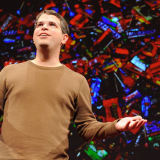I would like to introduce TED, which proposes a very Difficult theory.
Bill Eckstrom is recognized as a leading authority in metric-based performance coaching and growth. He founded the Ecsell Institute in 2008 to explore and disseminate knowledge on enhancing performance and growth. His career spans over 27 years, initially in sales and then in various leadership roles.
Eckstrom is known for his book, “The Coaching Effect,” which emphasizes the impact of leadership on performance.
The importance of “Growth Rings” is as follows. Honestly, this theory is quite difficult.
- Stagnation – 1st ring (start point)
- Chaos – 4th ring
- Order – 2nd ring
- Complexity – 3rd ring (goal)

from his slide
1. 1st.“Stagnation” – 1st ring (start point)
- Emotion
At this stage, you might feel a sense of comfort, yet also a feeling of being stuck. With little change or challenge, boredom or frustration can set in. - Perception
You realize that you’re not growing or learning anything new. It’s like being in a comfort zone that’s too comfortable, limiting your potential.
from 1st.”Stagnation” to 2nd.”Order” – move forward the ring
- Reason and Catalyst
Stagnation is marked by a lack of growth. Organizations suffer from a shortage of new ideas and innovation, leading to stagnant results. The main catalyst for moving out of this stage is pressure from both inside and outside the organization. This includes intensified competition, changing customer demands, or increasing internal dissatisfaction. - How to Transition
Organizations establish order by restructuring to enhance efficiency and productivity, and standardizing processes. Leadership provides a clear vision and direction, formulating plans to achieve goals.
from 2nd.”Order” to 1st.”Stagnation” – move back the ring
- Reason and Catalyst
The transition from order to stagnation is caused by an over-reliance on predictability and comfort. Ekstrom explains that continually doing or thinking about something in the same way eventually leads to a halt in growth. This is because comfort, which is found in predictability, makes order dangerous by limiting the opportunities for growth and innovation. - How to Transition
To avoid the transition into stagnation, one must actively seek discomfort and embrace change. Growth only occurs in a state of discomfort, so it’s essential to challenge the status quo, introduce new ideas, and break out of comfortable patterns. This involves taking risks, trying new things, and learning from failures to prevent the environment from becoming too safe and growth-limiting.
2. “Chaos” – 4th ring
- Emotion
Chaos often feels overwhelming. With too much change happening too quickly, you might feel out of control or anxious. - Perception
While you recognize the need for stability, you also see the potential for growth. If you can find a way through the chaos, it can serve as a catalyst for change.
3. “Order” – 2nd ring
- Emotion
Order brings a sense of calm and predictability. Knowing what’s going to happen and having routines makes you feel confident. - Perception
You value stability but understand that too much predictability can hinder growth. You may start to feel the itch for new challenges.
from 2nd.”Order” to 3rd.”Complexity” – move forward the ring
- Reason and Catalyst
In the stage of order, an organization is stable, and processes are established. However, excessive structuring can hinder innovation and lack flexibility. The transition to complexity is spurred by the need to respond to changes in the external environment, such as market shifts, technological advancements, or the emergence of new competitors. - How to Transition
Organizations move to a more flexible structure and cultivate a culture that promotes innovation and creativity, embracing complexity. Diversity of thought and approaches is encouraged, and teams become more autonomous.
from 3rd.”Complexity” to 2nd.”Order” – move back the ring
- Reason and Catalyst
Although Ekstrom’s speech primarily focuses on moving from comfort to growth through embracing complexity, transitioning from complexity to order involves recognizing when the unpredictability and challenges of complexity need to be balanced with stability and predictability. This might be sought after periods of intense change or innovation, where some level of predictability is necessary to consolidate gains and ensure sustainable growth. - How to Transition
Transitioning from complexity to order often signifies a retreat into safety and predictability at the expense of innovation and growth. This process involves narrowing down the diverse and innovative approaches that complexity encourages, conforming to standardized processes and rigid routines. While it aims to create stability, this shift can stifle creativity and flexibility, potentially leading to stagnation. The drive to make everything manageable and repeatable may inadvertently suppress new ideas and discourage the dynamic change necessary for sustained growth, signaling a downgrade in the organization’s developmental trajectory.
4. “Complexity” – 3rd ring (goal)
- Emotion
Complexity is both exhilarating and daunting. You face new challenges that push you out of your comfort zone, which can be both stimulating and uncomfortable. - Perception
Overcoming complexity requires new skills and adaptability. Learning how to handle uncertain and complex situations is where true growth happens.
from 4th.”Chaos” to 3rd.”Complexity” – move forward the ring
- Reason and Catalyst
Chaos is marked by a complete lack of predictability and control, often triggered by internal or external disruptions. The move towards complexity is driven by the recognition that while complete control is impossible, some level of order and predictability is necessary for growth. This transition is often catalyzed by the need to adapt to changes and challenges in a way that allows for both stability and innovation. - How to Transition
Navigating from chaos to complexity requires embracing unpredictability as a part of growth, learning to adapt to new situations flexibly, and finding opportunities for innovation within the disorder. It involves developing strategies to manage the unknown and making conscious choices that lead to growth, even in the face of discomfort.
from 3rd.”Complexity” to 4th.”Chaos” – move back the ring
- Reason and Catalyst: At the complexity stage, organizations possess a variety of innovations and high adaptability. However, excessive complexity can become difficult to manage and may cause a loss of direction. The transition to chaos is triggered by a lack of management, over-distribution of resources, or intensification of internal conflicts.
- How to Transition: Organizations face unpredictable changes, with plans and processes struggling to keep up. At this stage, short-term responses are prioritized, often at the expense of long-term strategies and goals.



